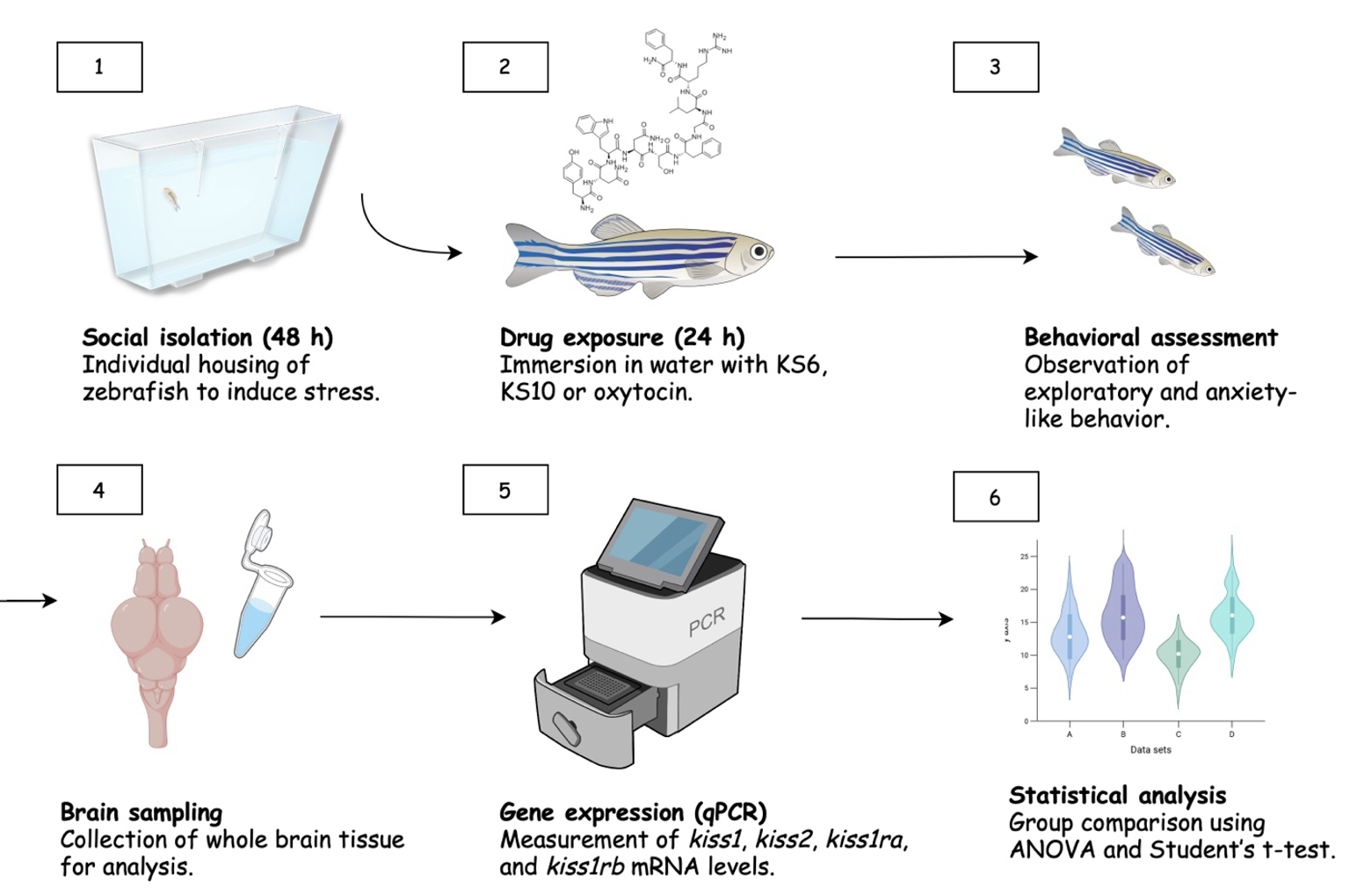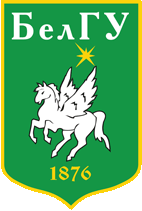Effect of social isolation and kisspeptin analogues (KS6 and KS10) on the expression of KISS1, KISS2, and their receptors in danio rerio
DOI:
https://doi.org/10.18413/rrpharmacology.11.597Abstract
Introduction: The kisspeptin system regulates both reproductive and stress-related neuroendocrine functions. In zebrafish (Danio rerio), social isolation disrupts the expression of kiss1, kiss2, and their receptors (kiss1ra, kiss1rb). This study investigates whether kisspeptin analogues KS6 and KS10 can reverse these effects and compares them with the well-known neuropeptide oxytocin.
Materials and Methods: Adult zebrafish were exposed to 48-hour social isolation and treated with KS6, KS10 (0.1 mg/L), or oxytocin (0.019 IU/L). Total RNA was extracted from whole brains, followed by cDNA synthesis and quantitative PCR targeting kiss1, kiss2, kiss1ra, and kiss1rb. Gene expression was normalized to gapdh. Statistical significance was assessed using one-way ANOVA and Student’s t-test.
Results and Discussion: Social isolation downregulated kiss1, kiss2, and kiss1ra, and upregulated kiss1rb. KS6 significantly increased kiss1 expression and normalized kiss1rb levels. KS10 partially restored kiss1 and kiss2, but reduced kiss1ra and further elevated kiss1rb. Oxytocin reversed all isolation-induced changes. KS6 showed the most consistent restorative effects, whereas KS10 demonstrated a more selective receptor profile, suggesting differential downstream signaling.
Conclusion: KS6 effectively reversed social isolation-induced dysregulation of kisspeptin signaling in zebrafish, indicating its potential for modulating neuroendocrine responses to stress. KS10 exhibited selective receptor modulation, which may be valuable for fine-tuned therapeutic strategies. These findings highlight the distinct pharmacological profiles of kisspeptin analogues in stress-related contexts.
Graphical Abstract

Keywords:
Danio rerio, gene expression, kisspeptin analogues, neuroendocrinology, oxytocin, social isolation, stress response, zebrafishReferences
Akinrinade I, Kareklas K, Teles MC, Reis TK, Gliksberg M, Petri G, Levkowitz G, Oliveira RF (2023) Evolutionarily conserved role of oxytocin in social fear contagion in zebrafish. Science 379(6638): 1232–1237. https://doi.org/10.1126/science.abq5158 [PubMed]
Biran J, Ben-Dor S, Levavi-Sivan B (2008) Molecular identification and functional characterization of the kisspeptin/kisspeptin receptor system in lower vertebrates. Biology of Reproduction 79(4): 776–786. https://doi.org/10.1095/biolreprod.107.066266 [PubMed]
Golts VA, Perova AP, Lebedev AA, Lizunov AV, Nadbitova ND, Bychkov ER, Purveev SS, Shabanov PD (2024) Effect of kisspeptin analogues on exploratory behavior in zebrafish. Experimental and Clinical Pharmacology 87(12): 3–7. https://doi.org/10.30906/0869-2092-2024-87-12-3-7
Ibos KE, Bodnár É, Bagosi Z, Bozsó Z, Tóth G, Szabó G, Csabafi K (2021) Kisspeptin analogues modulate stress-induced behaviors in zebrafish. Biomedicines 9(2): 112. https://doi.org/10.3390/biomedicines9020112
Ogawa S, Parhar IS (2018) Biological significance of kisspeptin-kiss 1 receptor signaling in the habenula of teleost species. Frontiers in Endocrinology (Lausanne) 9: 222. https://doi: 10.3389/fendo.2018.00222. PMID: 29867758; PMCID: PMC5949316.
Onuma TA, Duan C (2012) Regulation of the endocrine and growth systems by the kisspeptin/GPR54 system in fish. The FASEB Journal 26(7): 2941–2950. https://doi.org/10.1096/fj.11-201095 [PubMed]
Perova AP, Golts VA, Lebedev AA, Bychkov ER, Beznin GV, Kosyakova GP, Shabanov PD (2024) Comparative effect of kisspeptin analogues on gene expression under social stress in zebrafish. Clinical Pharmacology & Drug Therapy 22(2): 76–80. https://doi.org/10.25557/2310-0435.2024.02.76-80
Shahjahan M, Doi H, Ando H, Kitahashi T, Parhar IS (2010) Role of kisspeptin in fish reproduction. General and Comparative Endocrinology 169(1): 48–57. https://doi.org/10.1016/j.ygcen.2010.07.009 [PubMed]
Shi Y, Zhang Y, Wang Y, Wang Y, Wu J, Xu Q (2010) Kisspeptin and gonadotropin regulation in zebrafish. Biology of Reproduction 83(1): 63–74. https://doi.org/10.1095/biolreprod.109.080044
Sivalingam M, Parhar IS (2022) Neuroendocrine regulation by kisspeptin in teleosts: multiple functions beyond reproduction. Frontiers in Neuroendocrinology 64: 100951. https://doi.org/10.1016/j.yfrne.2021.100951
Tunbak H, Vazquez-Prada M, Hollis V, Williams A, Aryal A, Calvigioni D, Westmoreland T, Randlett O (2020) The impact of social isolation on brain activity in zebrafish. eLife 9: e55863. https://doi.org/10.7554/eLife.55863
Published
How to Cite
Issue
Section
License
Copyright (c) 2025 Perova AP, Golts VA, Pyurveev SS, Lizunov AV, Sekste EA, Potapkin AM, Eresko SO, Lysakovsky AV, Airapetov MI, Lebedev AA, Shabanov PD

This work is licensed under a Creative Commons Attribution 4.0 International License.
 Русский
Русский
 English
English

